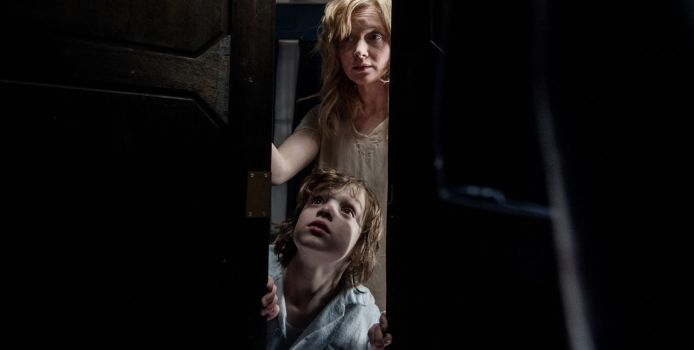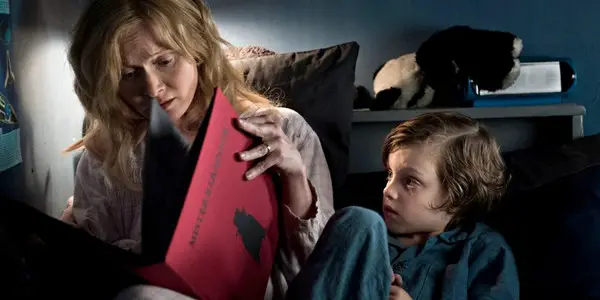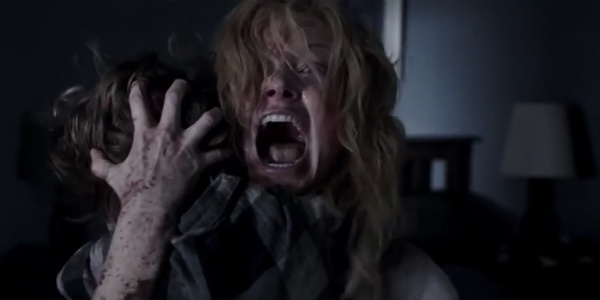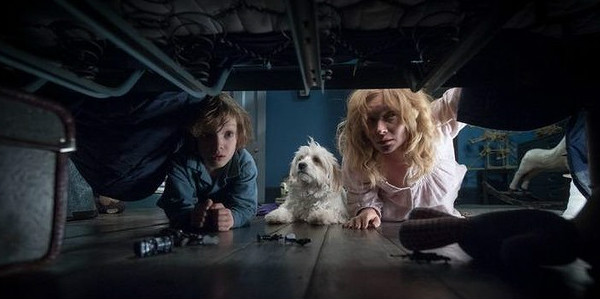THE BABADOOK: Australia Reinvents The Modern Horror movie

Sam is an English Literature student at the University of…
“If it’s in a word, or it’s in a look, you can’t get rid of The Babadook“. The mainstream horror genre is in a bad state at the moment. In the wake of the success of Paranormal Activity, Hollywood studios are taking advantage of the huge financial potential of the genre, and the fact that you can spend very little money on a horror film and make a huge profit off of teenage audiences. So we are often treated to small-budget, lazy and just unscary fare such as the slew of Paranormal Activity sequels, The Purge (what a wasted concept), Devil’s Due, and recently Ouija, which got a whopping 8% rating on Rotten Tomatoes. Cheap jumps, gore, and shaky cameras have replaced the truly difficult purpose of horror filmmaking, which is to genuinely scare your audience.
We need something to come along and shake up the mould, to remind us that horror is an artistically valid genre. And this little indie film from Australia, that made waves on its premiere at the Sundance Film Festival and currently boasts a 98% on the aforementioned site (what did critics think of Ouija again?), may just be that. Intelligent, emotionally powerful, masterfully acted and, most of all, terrifying, The Babadook is easily the best horror film in years.
A nightmare picturebook
The film is set in the suburbs of Adelaide, but if not for the Antipodean accents you wouldn’t notice. Debut writer/director Jennifer Kent shoots in bleak, wintry greys and blues, creating an ominous, gloomy Australia very unlike the image usually presented in the movies. Amelia (Essie Davis) is a single mother struggling to raise a troubled child Sam (Noah Wiseman), who is terrified of monsters. There is something unsettlingly weird and hard to like about Sam, and there’s the added dimension that Amelia’s husband was killed on the way to his birth. It’s a difficult relationship made worse when Sam picks a book off the shelf called “Mister Babadook” and asks for it to be read to him.

It’s a pop-up picturebook with creepy, nightmarish illustrations, and the designers deserve praise (maybe slight concern) for their twisted imaginations. The at-first innocent story told in the pictures slowly tells of the titular character’s plans to invade the reader’s house and make them wish they were dead. Sam is understandably terrified. Soon, strange things start happening inside the house, with the book returning despite Amelia’s attempts to destroy it. Amelia begins to understand her son’s fear of monsters, and what follows is an excellent construction of tension, dread, and fear.
Gets under the viewer’s skin
Many horrors directors seem to interpret scaring the audience as punctuating a quiet scene with a sudden scary image and sound to make the audience jump. Some films do this well, like Insidious, but it’s easy to do, and lazy, and it doesn’t really elicit any emotion other than an instinctive reaction. Kent understands that to really get under a viewer’s skin, you need to use the images on screen (or lack thereof) to suggest something far more horrible and terrifying, knowing that the imagination can create things far more scary than anything you can show on a cinema screen. The Babadook barely appears as more than glimpses and shadow for much of the film. The nightmarish cartoon of him from the picture book is in our heads, and we try and turn that into a real creature.

The design of Mister Babadook himself is original and scary, but to reveal him too soon would ruin the slow release of visual information. More impressive than the use of imagery is the sound design, which uses grinding teeth, insects, a screaming child and the classic horror trope of knocking on a door. In one scene, shown in the trailer below, Amelia answers the phone to hear a goat-like voice croak: “ba…ba…dook.” Kent is inventive in the ways she has the creature appear, too. In one scene he pops up in the background of a Georges Méliès film playing on TV, in a scene that may change the way I look at the film Hugo.
Complex central performances
All the best horror is based around the simplest, primal fears that everyone shares. In this case, it’s the idea of your child or family hurting you, or wanting to hurt your family. While the first act sets up Sam as a nasty, almost devilish child and Amelia as a sympathetic mother, the relationship becomes complex and ambiguous as the Babadook’s haunting takes hold, and we begin to fear that Amelia could be the dangerous one in the family. The Babadook serves as a symbol of her grief, her depression, and the fear that deep down she resents Sam for his responsibility in her husband’s death. This is what makes the film so brilliant. There is a clear emotional story about a mother and a son, complex and excellently portrayed by the two central actors.
The horror aspect, while genuinely scary on its own terms, is deeply entwined in this relationship, and develops it in a way that a standard drama couldn’t. This could not be pulled off without two strong performances, and Davis and Wiseman are more than up to the challenge. Davis captures the haunted face of a woman who cannot deal with the raising of her child, while Wiseman shows a nuance and subtlety that is almost completely lacking in child actors. When he’s irritating, it’s because he and the director want him to be.

The Babadook is loosely based on a short film called Monster, also directed by Kent. In that piece, which is only 8 minutes long, the monster serves less as a symbol for depression and grief than fear in general. If The Babadook has a flaw, it’s that it uses the same ending as Monster, which worked well in a short film but is less satisfying in a feature-length story. The final scenes work more as a comment on the film’s themes than as a conclusion to the story, which feels somewhat unfinished and doesn’t quite match the rest of what we’ve seen. But this is a minor complaint for a film that breathes fresh air into a stale genre.
The verdict
It’s remarkable that a tiny film in a genre with little respect has got this much acclaim, and it deserves box office success to go along with it. Ten years ago a little indie horror called Saw shook up the genre and ushered in several years of the hyperviolent, mildly sadistic “torture porn” style. I doubt this will have as much success and pop-culture legacy, but it would be great if it sparked its own reinvention of modern horror: a wave of classically made, emotionally resonant films with an emphasis on performance. Realistically, it probably won’t. But The Babadook has the potential to be the cult classic horror of this decade, and those who see it won’t forget Mister Babadook very easily.
Does The Babadook signal a new direction for the horror genre? Let us know in the comments.
(top image: The Babadook – source: IFC)
Does content like this matter to you?
Become a Member and support film journalism. Unlock access to all of Film Inquiry`s great articles. Join a community of like-minded readers who are passionate about cinema - get access to our private members Network, give back to independent filmmakers, and more.
Sam is an English Literature student at the University of Sheffield. He likes film, writing, and writing about film. He didn't think Prometheus was that bad.













